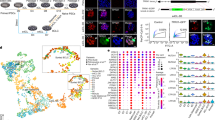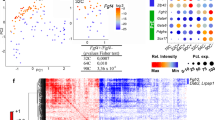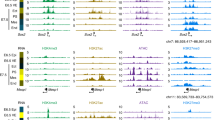Abstract
Pluripotency is established through genome-wide reprogramming during mammalian pre-implantation development, resulting in the formation of the naive epiblast. Reprogramming involves both the resetting of epigenetic marks and the activation of pluripotent-cell-specific genes such as Nanog and Oct4 (also known as Pou5f1)1,2,3,4. The tight regulation of these genes is crucial for reprogramming, but the mechanisms that regulate their expression in vivo have not been uncovered. Here we show that Nanog—but not Oct4—is monoallelically expressed in early pre-implantation embryos. Nanog then undergoes a progressive switch to biallelic expression during the transition towards ground-state pluripotency in the naive epiblast of the late blastocyst. Embryonic stem (ES) cells grown in leukaemia inhibitory factor (LIF) and serum express Nanog mainly monoallelically and show asynchronous replication of the Nanog locus, a feature of monoallelically expressed genes5, but ES cells activate both alleles when cultured under 2i conditions, which mimic the pluripotent ground state in vitro. Live-cell imaging with reporter ES cells confirmed the allelic expression of Nanog and revealed allelic switching. The allelic expression of Nanog is regulated through the fibroblast growth factor–extracellular signal-regulated kinase signalling pathway, and it is accompanied by chromatin changes at the proximal promoter but occurs independently of DNA methylation. Nanog-heterozygous blastocysts have fewer inner-cell-mass derivatives and delayed primitive endoderm formation, indicating a role for the biallelic expression of Nanog in the timely maturation of the inner cell mass into a fully reprogrammed pluripotent epiblast. We suggest that the tight regulation of Nanog dose at the chromosome level is necessary for the acquisition of ground-state pluripotency during development. Our data highlight an unexpected role for allelic expression in controlling the dose of pluripotency factors in vivo, adding an extra level to the regulation of reprogramming.
This is a preview of subscription content, access via your institution
Access options
Subscribe to this journal
Receive 51 print issues and online access
$199.00 per year
only $3.90 per issue
Buy this article
- Purchase on Springer Link
- Instant access to full article PDF
Prices may be subject to local taxes which are calculated during checkout




Similar content being viewed by others
References
Mitsui, K. et al. The homeoprotein Nanog is required for maintenance of pluripotency in mouse epiblast and ES cells. Cell 113, 631–642 (2003)
Chambers, I. et al. Functional expression cloning of Nanog, a pluripotency sustaining factor in embryonic stem cells. Cell 113, 643–655 (2003)
Nichols, J. et al. Formation of pluripotent stem cells in the mammalian embryo depends on the POU transcription factor Oct4. Cell 95, 379–391 (1998)
Reik, W. Stability and flexibility of epigenetic gene regulation in mammalian development. Nature 447, 425–432 (2007)
Gribnau, J., Hochedlinger, K., Hata, K., Li, E. & Jaenisch, R. Asynchronous replication timing of imprinted loci is independent of DNA methylation, but consistent with differential subnuclear localization. Genes Dev. 17, 759–773 (2003)
Silva, J. et al. Nanog is the gateway to the pluripotent ground state. Cell 138, 722–737 (2009)
Dietrich, J. E. & Hiiragi, T. Stochastic patterning in the mouse pre-implantation embryo. Development 134, 4219–4231 (2007)
Nichols, J., Silva, J., Roode, M. & Smith, A. Suppression of Erk signalling promotes ground state pluripotency in the mouse embryo. Development 136, 3215–3222 (2009)
Morrisey, E. E., Ip, H. S., Lu, M. M. & Parmacek, M. S. GATA-6: a zinc finger transcription factor that is expressed in multiple cell lineages derived from lateral mesoderm. Dev. Biol. 177, 309–322 (1996)
Chambers, I. et al. Nanog safeguards pluripotency and mediates germline development. Nature 450, 1230–1234 (2007)
Kalmar, T. et al. Regulated fluctuations in Nanog expression mediate cell fate decisions in embryonic stem cells. PLoS Biol. 7, e1000149 (2009)
Ying, Q. L. et al. The ground state of embryonic stem cell self-renewal. Nature 453, 519–523 (2008)
Wray, J., Kalkan, T. & Smith, A. G. The ground state of pluripotency. Biochem. Soc. Trans. 38, 1027–1032 (2010)
Canham, M. A., Sharov, A. A., Ko, M. S. & Brickman, J. M. Functional heterogeneity of embryonic stem cells revealed through translational amplification of an early endodermal transcript. PLoS Biol. 8, e1000379 (2010)
Weaver, J. R., Susiarjo, M. & Bartolomei, M. S. Imprinting and epigenetic changes in the early embryo. Mamm. Genome 20, 532–543 (2009)
Shufaro, Y. et al. Reprogramming of DNA replication timing. Stem Cells 28, 443–449 (2010)
Jørgensen, H. F. et al. The impact of chromatin modifiers on the timing of locus replication in mouse embryonic stem cells. Genome Biol. 8, R169 (2007)
Magklara, A. et al. An epigenetic signature for monoallelic olfactory receptor expression. Cell 145, 555–570 (2011)
Tsumura, A. et al. Maintenance of self-renewal ability of mouse embryonic stem cells in the absence of DNA methyltransferases Dnmt1, Dnmt3a and Dnmt3b. Genes Cells 11, 805–814 (2006)
Kagey, M. H. et al. Mediator and cohesin connect gene expression and chromatin architecture. Nature 467, 430–435 (2010)
Messerschmidt, D. M. & Kemler, R. Nanog is required for primitive endoderm formation through a non-cell autonomous mechanism. Dev. Biol. 344, 129–137 (2010)
Hough, S. R., Clements, I., Welch, P. J. & Wiederholt, K. A. Differentiation of mouse embryonic stem cells after RNA interference-mediated silencing of OCT4 and Nanog. Stem Cells 24, 1467–1475 (2006)
Hatano, S. Y. et al. Pluripotential competence of cells associated with Nanog activity. Mech. Dev. 122, 67–79 (2005)
Bolzer, A. et al. Three-dimensional maps of all chromosomes in human male fibroblast nuclei and prometaphase rosettes. PLoS Biol. 3, e157 (2005)
Lewis, A. et al. Epigenetic dynamics of the Kcnq1 imprinted domain in the early embryo. Development 133, 4203–4210 (2006)
Boyer, L. A. et al. Core transcriptional regulatory circuitry in human embryonic stem cells. Cell 122, 947–956 (2005)
Sage, D., Unser, M., Salmon, P. & Dibner, C. A software solution for recording circadian oscillator features in time-lapse live cell microscopy. Cell Div. 5, 17 (2010)
Acknowledgements
We thank M. Okano for providing the triple DNA methyltransferase knockout cells, P. Avner and P. Clerc for hybrid ES cells, H. Schöler for the Oct4 probe (GOF6.1), J. Jaubert for M. musculus castaneus mice, R. Kemler and S. Rudloff for the NanogGt1mice, G. Charvin for advice on time-lapse analysis. We also thank M. Koch, A. Dierich, M.-C. Birling, E. Heard and I. Okamoto for advice, and A. Burton, E. Heard and O. Pourquie for critical reading of the manuscript. M.-E.T.-P. acknowledges funding from AVENIR/INSERM, ANR-09-Blanc-0114, Epigenesys NoE and FRM Alsace. Y.M. is a recipient of an EMBO long-term fellowship (ALTF864-2008, 2009) and a JSPS postdoctoral fellowship (2010–2011).
Author information
Authors and Affiliations
Contributions
Y.M. conceived, designed and performed the experiments in this study and analysed the data; M.-E.T.-P. conceived the project and designed and supervised the study. Y.M. and M.-E. T.-P wrote the manuscript.
Corresponding author
Ethics declarations
Competing interests
The authors declare no competing financial interests.
Supplementary information
Supplementary Information
This file contains Supplementary Figures 1-8 with legends and Supplementary Table 1. (PDF 3671 kb)
Supplementary Movie 1
This movie shows serial confocal sections (0.3 μm step) of 4-cell stage embryos. Nascent transcripts of Nanog (yellow) and Oct4 (red) were detected by RNA-FISH. DNA was stained with DAPI in blue. (MOV 8251 kb)
Supplementary Movie 2
This movie shows serial confocal sections (0.3 μm step) of ICM cells of late blastocyst. Nascent transcript of Nanog (yellow) was visualized by RNA-FISH. DNA was stained with DAPI in blue. (MOV 3143 kb)
Supplementary Movie 3
This movie shows serial confocal sections (0.3 μm step) of ES cells cultured with serum and LIF. Nascent transcripts of Nanog (yellow) and Oct4 (red) were visualized by RNA-FISH. DNA was stained with DAPI in blue. (MOV 1437 kb)
Supplementary Movie 4
This movie shows serial confocal sections (0.3 μm step) of ES cells cultured with 2i. Nascent transcripts of Nanog (yellow) and Oct4 (red) were visualized by RNA-FISH. DNA was stained with DAPI in blue. (MOV 2637 kb)
Supplementary Movie 5
This movie shows time-lapse imaging of NGR ES cells cultured in medium containing LIF. Images are acquired along 7 Z-planes spanning 17.5 μm every 20 min for 38 hrs under a spinning disk confocal. Series of maximum intensity projection at each time point is converted to the movie. (MOV 9482 kb)
Rights and permissions
About this article
Cite this article
Miyanari, Y., Torres-Padilla, ME. Control of ground-state pluripotency by allelic regulation of Nanog. Nature 483, 470–473 (2012). https://doi.org/10.1038/nature10807
Received:
Accepted:
Published:
Issue Date:
DOI: https://doi.org/10.1038/nature10807
This article is cited by
-
CasTuner is a degron and CRISPR/Cas-based toolkit for analog tuning of endogenous gene expression
Nature Communications (2023)
-
Characterization of a Distinct State in the Continuum of Pluripotency Facilitated by Inhibition of PKCζ in Mouse Embryonic Stem Cells
Stem Cell Reviews and Reports (2023)
-
NANOG initiates epiblast fate through the coordination of pluripotency genes expression
Nature Communications (2022)
-
NANOG prion-like assembly mediates DNA bridging to facilitate chromatin reorganization and activation of pluripotency
Nature Cell Biology (2022)
-
A cytokine screen using CRISPR-Cas9 knock-in reporter pig iPS cells reveals that Activin A regulates NANOG
Stem Cell Research & Therapy (2020)
Comments
By submitting a comment you agree to abide by our Terms and Community Guidelines. If you find something abusive or that does not comply with our terms or guidelines please flag it as inappropriate.



